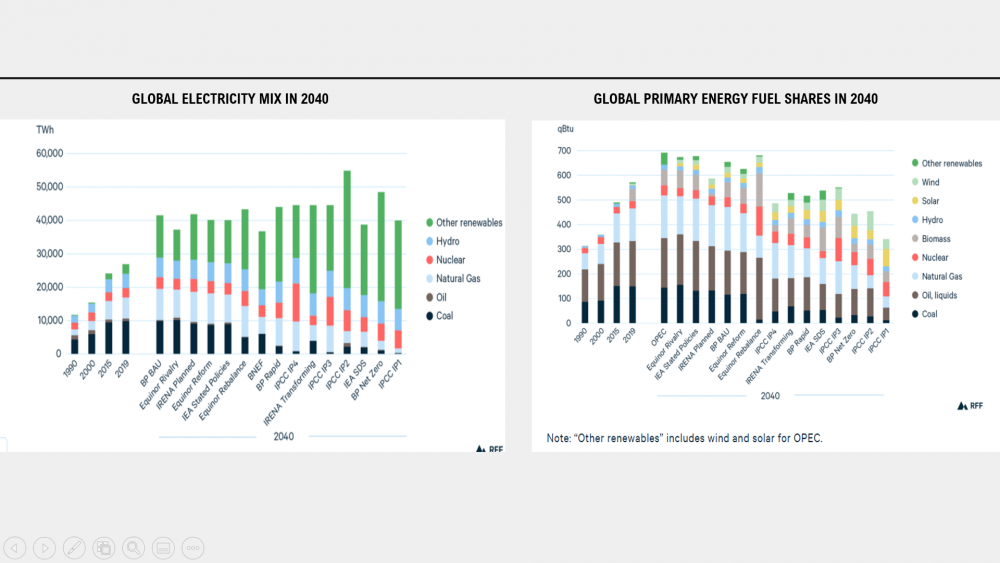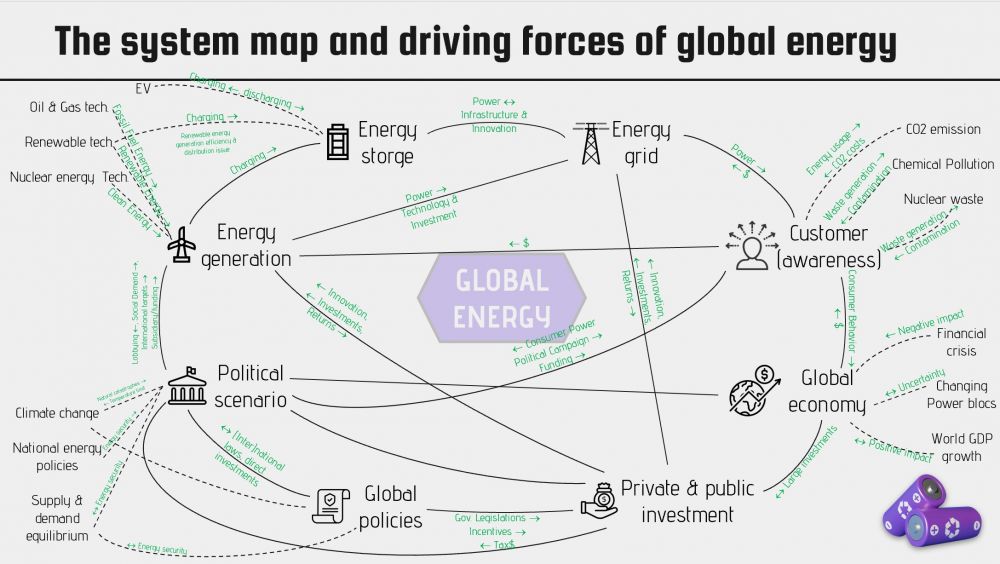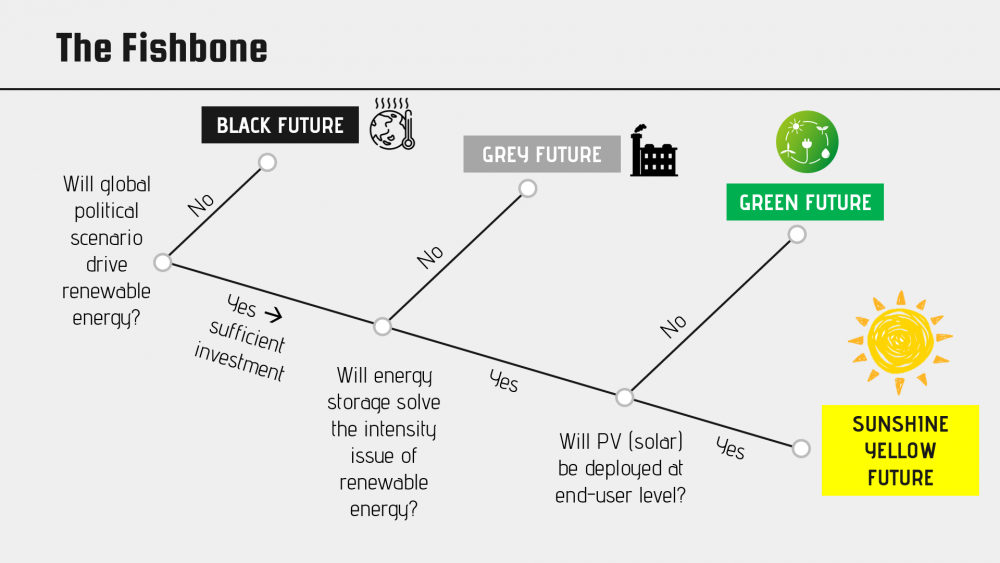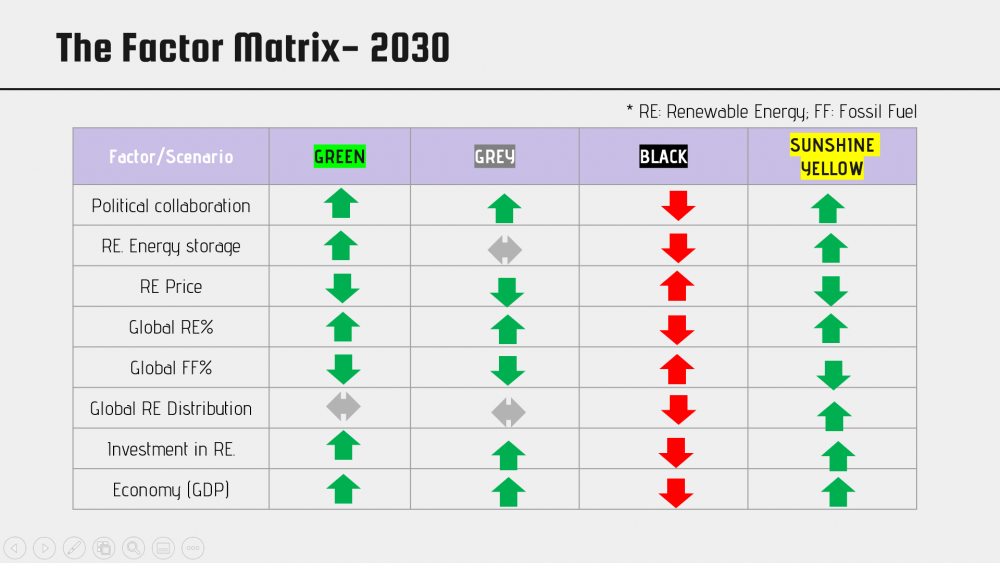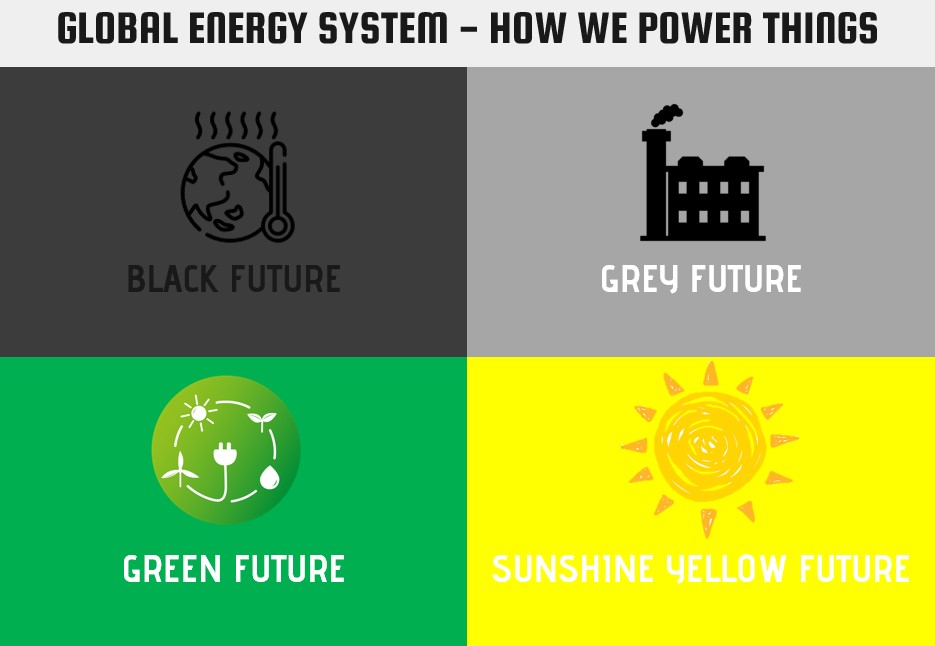Global Energy System- How we power things
Team Members
Abdallah Mteir
Hadeel Khawaldeh
Minh Nguyen Duc
Sebastian Vinkenfluegel
Richa Kushwaha
Wei Chou Wang
Project Overview
Why do we need scenarios to be ready for the future?
- Long-term energy projections from credible & esteem agencies vary widely, depending on underlying assumptions and methodologies.
- Disruptive technologies in renewable energy space are on a growth curve to become the primary source of energy.
This wiki examines several scenarios related to the future of the Global Energy System by 2030.
Questions to ask about the Global Energy System
- How much energy is produced in the world?
- What is the geographical split and the spread of energy production? Who are the most important players?
- How much energy is used in the world? What is the geographical split?
- How many resources of fossil fuels are in the world?
- How many reserves of fossil fuel are in the world?
- What technologies are there for energy production?
- What are energy storage technologies out there?
- How much energy is used in what form (electricity, heat, transport)?
- What are the major impacts to increase energy efficiency?
- What is the seasonality of energy consumption? (day / month / year)
- What is the current carbon footprint in the energy production system and consumption?
- What’s the most efficient alternative resource of fossil fuels currently?
- What’s the biggest challenge of renewable energy currently?
- How do we change people’s mindset to use renewable energy even it may be more expensive?
- What's the threshold for price/cost vs. capacity for production?
- How much does the price decrease per doubeling of generation capacity?
- How much private and public investments are made in the energy industry?
- What are current political scenarios driving global energy?
System Diagram
Systems Map Draft 1
Systems Map Draft 2
Driving Forces
Fishbone Analysis
Scenario Matrix Map
Scenarios
Scenario 1 - Black Future
(Minh Nguyen Duc)
Key Question:Will global political scenario drive renewable energy? Scenario Answer: No
Scenario Stats:
Surprising -/10
Likely -/10
Nobody would have thought that 2022 was the year the world political leaders decided to deprioritize the efforts for sustainability and energy transition in favor of the economic recovery after the COVID-19 pandemic, such a massive trade-off that caused the worst global crisis in energy management and how we power things in the history of mankind.
Starting in early 2020, the COVID-19 pandemic has quickly become an unprecedented disruption to all aspects of lives. According to Congressional Research Service, the virus has reduced global economic growth by -3.2% and shrunk global trade by -5.3% in 2020. In 2021, thanks to the vaccination scheme and re-opening policy, the situation showed signals of recovery, with the 2021 global economic growth forecast (on November 10, 2021) to be 5.9%. However, the mutated Omicron variant of the virus, discovered in November 2021, unfortunately quickly diminished the effort, creating strong pressure for world leaders across public and private sectors to reignite the growth at all costs. As a result, from 2022, the previously committed investments to foster the mass adoption of renewable energy, whether research and development, grid infrastructure, storage innovation, and adoption, etc, started to be deprioritized for other short-term value creation investments. Long story short, the world decided to sacrifice the medium and long-term impact for short-term economic recovery. Three years later, in 2025, regardless of all the efforts made, the global economy was recovering not at the expected speed. The world leaders, consequently, were debating about the right set of action and prioritization, whether to continue the path they were following or to go back to pre-COVID commitment to foster the energy transition. Meanwhile, conventional energy companies remained wanting to make more money; hence, making tremendous lobbying efforts to postpone the passing of the laws to increase the utilization of green energy, an act that was fairly successful in making the delays. This, on the other hand, received countless criticism from environmentalists, NGOs, and activists. Around the world, many protests have been happening, aim to raise awareness of climate change and to ask for a better commitment and investment in the energy transition.
Despite all of those, the reluctance from the governments and the public sector remained to major roadblock for the progress of energy transition. This, unfortunately, brought about the biggest energy crisis in human history, which the world was witnessing, in 2030. In the course of a decade, the percentage of renewable energy consumption in the world only increased marginally by 10% (from 19% to 29%), which means that renewable energy accounts for less than one-third of the world’s consumption today, which comes extremely short vs the ambition set before COVID times. What’s more, over the past ten years, the world has added 0.5 billion habitats, resulting in 27% increase in energy demand, which then led to more CO2 emissions. As a result, global warming is at the highest-ever alert – the average temperature of the world has gone up by 1.8 degrees Celsius, reaching its peak in history. Chemical pollution seriously jeopardizes people’s and animals’ health. The sea level has risen by 36 cm, resulting in losing half of the Netherlands, and this will continue to be the case. On this chaotic backdrop, the world is getting over-populated as we are losing more land. And the Earth will soon become a dying planet until the equilibrium is established again.
Scenario 2 - Grey Future
(Sebastian Vinkenflügel, Wei Chou Wang)
Key Questions:
Will global political scenario drive renewable energy? Scenario Answer: Yes
Will energy storage solve the intensity issue of renewable energy? Scenario Answer: No
2022
Nobody would have thought in year 2022, the new renewable energy act of the politics leads to a heavy push towards renewable energies with massive subsidies. With the wide availability of funding from politics, the installation on renewable energy, such as solar and wind increased significantly. Utility companies extended their investments and used available space to install photovoltaic and wind turbines. However, due to the sharp drop in price for photovoltaic installations, the focus relied mostly on solar energy.
2025
In 2025, even though the investments in renewable energies increased significantly, seasonal, and peak storage of energies did not keep up with the technology and stay below the installed capacity of the renewable energies. The availability of energy storage has only marginally increased. The current politics are not incentivizing the use of energy storage, which leads to a low interest and limited investments in research and development in that technology, for larger corporations. Fossil fuel energy is still needed to a large extend to close the gap between the renewable energy and the demand.
2031
The global economy heats up with a total GDP of $114 trillion. Global renewable energy investment reaches $694 billion (doubled from $365 billion in 2020), the energy storage capacity has only doubled (to 34 GW), marginally compared the renewable energy installations. The price of renewable energy dropped to $95/MWh (previously $190/MWh in 2022).
Due to the lack of peak and seasonal energy storage, the fossil fuel energy industry still has to keep its entire fossil power generation capacity available, in warm and cold reserve, to close the gap between renewable energy generation and customer demand during peak demands. Even though large capacities of renewable energy have been installed, the energy price has increased to almost $1 per kWh, because the old power plants need expensive maintenance to keep running. Costs which are directly forwarded to customers. Energy intensive industries, such as steel, are facing challenges to maintain profitability, while the high energy price on the end customer level increased the inequality. Low-income households are facing challenges to pay their electricity bills.
For days without wind, and little sun, the fossil fuel power generation needed to cover the entire peak demand. On days when the weather suddenly changed from a cloudy, windless day, to windy, with the wind blowing away the clouds, starting to power the wind turbines and ramping-up the solar power generation, the fossil fuel power generation is not able to shut down the same speed, due to the inflexibility of old power plans. Coal fired power plants need half a day to power-up or down, too slow for only 30 minutes until the wind has started the entire renewable energy power generation capacity, in a country like Germany. This provides a significant over generation, which causes the power grids to collapse. Local power outages to end-consumer are frequent, usually weekly, with several hours without power, sometimes up to an entire day, sometimes daily. The power outages are needed from the utility industry until the grids are stabilized again, and power is again available. Private homes usually have emergency diesel generators to keep the smartphone charged and the fridge running, adding exhaust, including carbon dioxide to the atmosphere, usually without any filters.
Local initiatives and protests are on the rise, demonstrating against renewable energies and high electricity prices. There are almost 100 times as many initiatives against renewable energies as there are for, while politicians are not revising their decision for renewables, leaving a grey future uncertain, alternating between new renewable energies and traditional fossil fuel energies.
Scenario 3 - Green Future
Key Questions:
Will global political scenario drive renewable energy? Scenario Answer: Yes
Will energy storage solve the intensity issue of renewable energy? Scenario Answer: Yes
Will PV (solar) be deployed at end-user level? Scenario Answer: No
Scenario Stats:
Surprising -/10
Likely -/10
Nobody thought that in 2022…
That renewable energy disruption will be swift and successful in the energy and transport sector by 2030. Oil, natural gas (methane), coal, and uranium will become obsolete for the purposes of generating significant amounts of electricity and powering the automobile.
By 2025, Successful innovation disruption in the storage of renewable energy to solve issues around energy intermittency. Traditional power stations will not be cost-effective, as cheap and clean energy is widely available.
By 2027, Energy generation and usage will become decentralized, democratic, and disruptive by this period. Every house will have its own energy production and usage for household usage, same with industries.
by 2030, Houses can sell the excess energy to spaces that will require more energy. Also, in terms of automobile fuel, energy will change to hydrogen and biobased fuel along with small and efficient electric energy storage.
Scenario 4 - Yellow Future (Decentralized, Disruptive, Democratic)
Key Questions:
Will global political scenario drive renewable energy? Scenario Answer: Yes
Will energy storage solve the intensity issue of renewable energy? Scenario Answer: Yes
Will PV (solar) be deployed at end-user level? Scenario Answer: Yes
Scenario Stats:
Surprising -/10
Likely -/10
In 2022 the end user started to demand to have renewable energy supplied, in terms of heating and electricity. The demand from the end user provided a significant pull through the energy industry emphasizing the expansion of renewalable energy, such as photovoltaic and wind power.
During the same year, the first developments of energy storage are made, this includes hydrogen and battery storage. However, the energy storage systems are not available on a large scale to provide balance to the electrical grid.
By year 2025, the pull of renewable energy results in the first larger installations of renewable energy installations. The power supply from renewables starts to become more vastly available and start to exceed the traditional power generations. The renewable energies started to destabilize the electricy grid, due to volatility. Furthermore, traditional power generation units still have to be kept as cold reserve to balance out the volatility of supply from the renewables.
The first breakthroughs for solid state batteries have been completed and the first companies experimented with the large-scale production.
By year 2027, the electricity grid becomes more destabilized due to the renewable energies. The end consumer is experiencing first outages in the electricity supply. However, larger outages were able to be avoided as that time. Additional renewable energy power stations are on the way to be completed during the next years. Due to the price drop PV installations on roofs become very common. First houses are being equipped with solid state batteries to balance the supply and demand and provide intermediate storage e.g. to load electrical cars. The production of solid-state batteries are now fully running. The demand is significant.
By 2030, most houses are equipped with solid state batteries and PV installations. Electricity is mostly produced on the low or medium voltage level and only shared within the community and only rarely beyond it. The batteries are balancing out the supply and demand. Storage installations of batteries are able to last for several days, in larger communities’ weeks, or even month, being able to meet supply and demand. Fossil fuel power plants are still kept available for long cloudy, days, without wind. However, the classical top-down energy supply is fully disrupted. Energy for houses becomes a very cheap resource for everybody.
